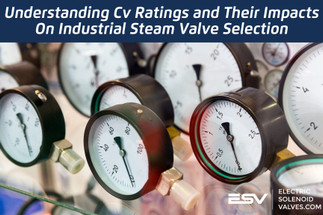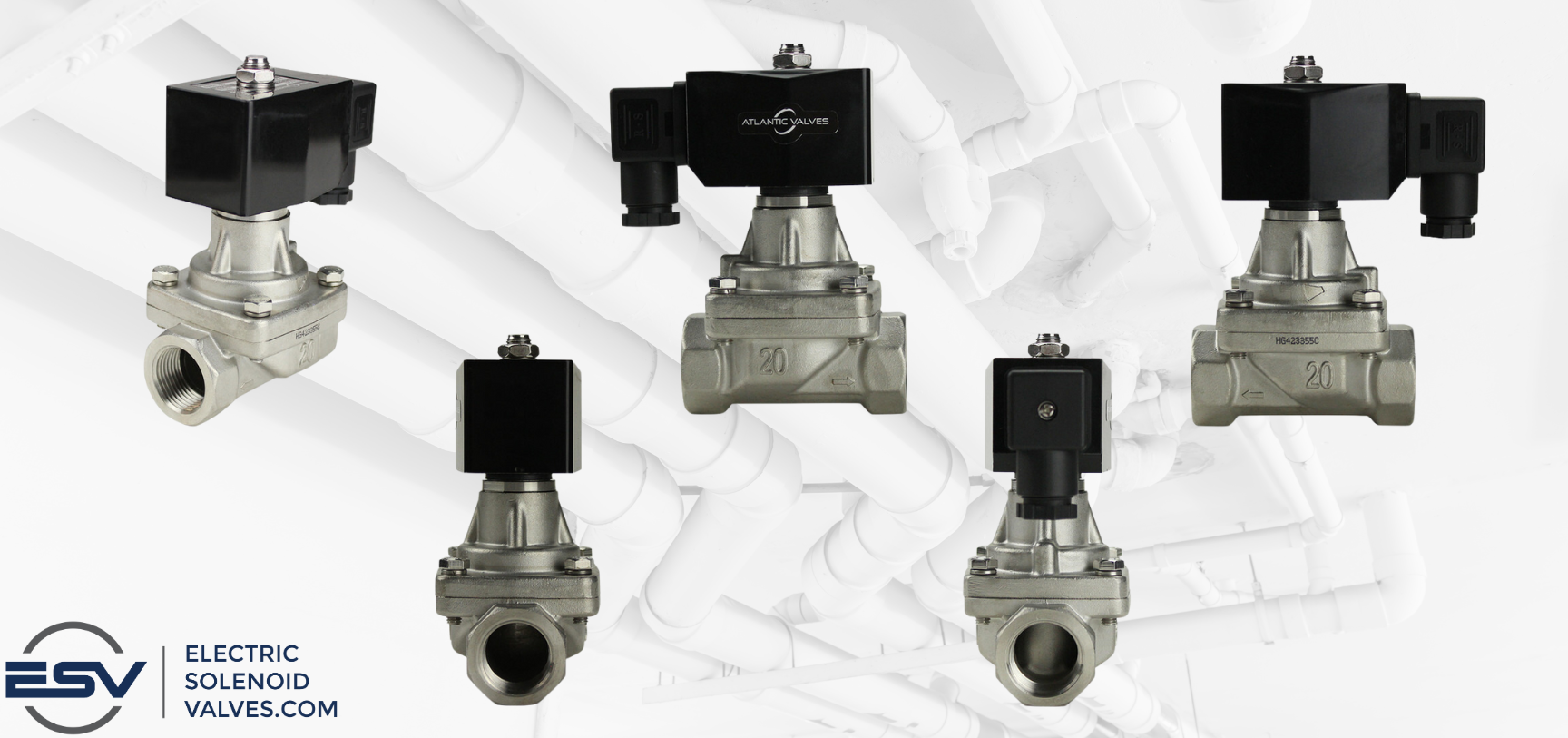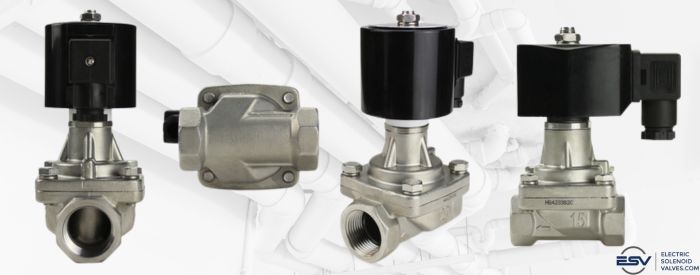Sep 6th 2024
Understanding Cv Ratings and Their Impacts On Industrial Steam Valve Selection
Are you looking for a steam valve for your industrial, commercial or residential functions? Are you confused about the different steam valve products in the Electric Solenoid Valves online catalog? Understanding the specifics of valves and their sizing criteria can be daunting. This post simplifies the process by explaining how to choose the correct steam valve based on its flow coefficient (Cv) ratings.
Steam valves are highly engineered flow control devices that regulate fluid flow in high-temperature and pressure environments. Whether you're choosing a solenoid steam valve or another type of valve, understanding Cv ratings is crucial for knowing which valve will work best in your system.
Stainless steel steam solenoid valve
Choosing steam valves with the appropriate Cv ratings has various operational benefits. The entire piping system that the steam valves serve will have better efficiencies and predictable flow rates and will be less prone to failure. Efficient steam systems offer better returns on investments in the long run. Let’s break what Cv ratings are and how it impacts steam valve sizing and selection, considering the characteristics of wet, saturated and dry steam.
What is Cv Rating
The Cv rating (flow coefficient) provide a standard method for sizing various industrial valves, including steam valves. It is an engineering value or parameter determining how much fluid flows past a valve under specific operating conditions.
The standard for specifying Cv ratings is the capacity of water (in Gallons) that can flow through a valve when the system experiences a pressure drop of 1 psi at standard temperature. The Cv rating of a steam valve specifies how much steam can flow through the valve per minute under certain flow conditions.
How do you calculate the Cv rating of a valve? The calculation is straightforward. The formula for calculating the Cv rating for any valve is:
Cv = Q √(SG / ΔP)
Where:
- Q - flow rate in gallons per minute (for steam valves, this is the flow rate of steam in gallons per minute)
- SG - is a ratio of the fluid’s density compared to water (where SG of water is 1)
- ΔP is the pressure drop across the valve (in psi)
3/4 inch stainless steel steam solenoid valves
To understand the Cv ratings of steam valves, consider a solenoid steam valve with a designed Cv rating of 8. It means that 8 gallons of steam will flow through the valve per minute when there is a pressure drop of 1 psi across the valve. Assigning Cv values to each steam valve means valve designers and pipeline engineers can predict how valves perform when subjected to different conditions in steam piping systems.
Calculating Cv ratings for steam valves varies since steam has varied characteristics in different applications and states. Steam is compressible, and its properties change over time . Engineers and designers should account for system-specific performance conditions like pressure and temperature to calculate the flow coefficient for each steam valve accurately.
Read more here - What Is Valve Flow Coefficient and How to Calculate It?
Why Cv Ratings Matter for Steam Valves
Finding the correct Cv values when designing or choosing valves is a step toward optimal system performance. Wrong Cv ratings of steam valves mean one selects oversized or undersized valves. In both situations, the integrity of steam systems is at risk.
Undersized Cv Rating
Choosing steam valves with smaller Cv ratings has various downsides. Installing such a valve in a piping system with a high flow rate requirement leads to one or more of the below performance issues.
Low flow rates - the valve will permit lower amounts of steam to flow through them. The flow rate may be below the intended or desired system flow rates. Under such conditions, downstream equipment receives less steam than intended. It can cause consequences like decreased heat transfer efficiency, slower production time for facilities relying on steam for routine operations or lower quality of products in processing units dependent on steam.
Increased energy consumption - a smaller Cv rating causes restricted steam flow across valves. The whole pipe system tries to compensate for the flow rate deficiencies by working harder than their designed capacities. For instance, boilers may generate more steam to satisfy the restricted flow. When this happens, the boiler consumes more fuel, increasing overall energy costs and eating into the slim profits of production processes.
Increased pressure drop - restricted steam flow through an undersized steam valve leads to increased pressure drop across the valve. The drop significantly reduces downstream pressure, directly impairing the performance and reliability of steam equipment like turbines or industrial heat exchangers.
Rapid wear and tear - under sizing steam valves based on their Cv ratings means exposing them to premature wear and tear. The valve experiences thermal and mechanical stress when operating beyond its optimal range and deviating from the desired system characteristics. These valves are prone to:
- Erosion due to high steam velocity. The valve restriction due to undersizing causes steam to flow faster than intended through the valve. The elevated steam velocity causes surface erosion and damage to internal components by abrasion. Valves servicing wet steam are more prone to impingement, which happens when high-velocity steam causes localized valve erosion on wetted valve surfaces.
- Valve cavitation occurs when undersized steam valves cause high-pressure drops. The sudden pressure drop may cause some steam to condense rapidly and evaporate, causing bubbles to form around the steam valves. These bubbles collapse as the steam flows downstream, negatively impacting subsequent processes. Cavitation causes the pitting of steam valves, increases piping system noise and vibration, and causes decreased valve accuracy due to the periodic degradation of steam valve parts.
- Thermal fatigue due to cyclic temperature variations. The valve experiences localized cooling and heating from the periodic rapid pressure drops. These temperature changes can cause valve distortion and cracking over time, limiting the valve’s ability to perform intended flow control functions.
Oversized Cv Ratings
Perhaps you are looking at a steam valve with a higher Cv value than the designed system capacity. What could go wrong? After all, the valve will successfully deliver the steam requirements of your piping system. Think again. It can be a miscalculation. Here is why.
Poor flow control - the steam valve will deliver the right amount of steam just before reaching its fully closed position. The valve cannot precisely regulate steam flow to downstream equipment and piping systems. The steam control systems may oscillate (hunting), leading to an unstable process steam supply.
Reduced efficiency - oversized steam valves are inefficient in two ways. They consume more energy than is necessary to supply the intended steam. They are less accurate than properly designed steam valves and can waste more steam in a similar industrial operation.
Regular valve overshoots - oversized valves supply more steam beyond the desired levels with minimal changes in valve positions. When this happens, the valve is said to have overshot. It causes downstream system inefficiencies and can damage piping equipment.
Appropriate Cv Ratings For Different Types Of Steam
Cv ratings for steam valves vary depending on which type of steam the valve services. There is no one-fit-all value when considering wet, dry and saturated steam . Here is a brief for navigating the intricacies of Cv ratings for each Steam category.
Wet steam - is a mixture of steam and water droplets. It means valves servicing this steam are more prone to media corrosion. It is necessary to design the valve with a Cv value that compensates for surface corrosion and the relatively lower density of the steam-water mixture. The Cv value for steam valves used for wet steam service is slightly lower than for a counterpart designed for dry steam service. Wet steam systems require higher mass flow rates to achieve the same heat transfer functions as dry steam systems. Wet steam valves should comfortably handle multiphase fluid flow and have hardened valve materials for minimal surface erosion by the steam-water mixture.
Dry steam - it is free from water droplets. Dry steam is ideal for applications requiring precise temperature and pressure control. Dry steam has a lower mass flow rate than wet steam in the same application. Piping systems with dry steam as service fluids benefit from valves with a higher Cv rating value than wet steam systems. A Cv value that guarantees the mid-range performance of a valve in dry steam service is ideal for long-term service and optimized flow control performance.
Saturated steam - the operating temperature of saturated steam ensures water and steam are at equilibrium. Saturated steam is essential for heating and sterilization operations. The ideal Cv rating for saturated steam service should ensure the valve facilitates smooth fluid flow without altering the properties of steam as it travels downstream. Changes in steam velocity around the valve can cause superheating or condensation, rapidly transforming steam heat exchange properties.
How to Select the Right Steam Valve for Your Application
1" Stainless Steel Steam Solenoid Valves
To select the right steam valve, follow these steps:
- Determine
Your System’s Flow Requirements:
- Calculate the flow rate and pressure drop for your system. This will guide you in choosing a valve with the appropriate Cv rating.
- Consider the
Type of Steam:
- Based on whether your system uses wet, dry, or saturated steam, choose a valve with a corresponding Cv rating.
- Consult
Product Specifications:
- Take a look at the steam solenoid valves available at Electric Solenoid Valves. For example, our stainless steel steam solenoid valves are designed to handle temperatures between 32°F to 356°F and are available in sizes from ½” to 1”. These valves offer the durability and flow control needed for high-pressure steam applications.
- Consult an
Expert:
- If you're unsure which Cv rating or valve material best suits your system, contact our in-house valve experts for advice. We can help you make an informed decision and for your steam system.
Final Words
Selecting a steam valve with the appropriate Cv rating is crucial for optimizing your system’s performance, safety, and efficiency. Whether you’re working with wet, dry, or saturated steam, understanding Cv ratings will help you avoid costly issues like energy waste and premature valve failure.
Electric Solenoid Valves' Catalog includes a range of high-quality solenoid steam valves, designed to meet various flow control needs. Not sure which valve is right for you? Get in touch with us today, and we’ll guide you through the selection process to find the perfect valve for your specific application.
Explore our range of steam solenoid valves and improve the efficiency of your steam system today.
Key Takeaways:
- Cv rating is a crucial factor in valve sizing, determining how much steam can pass through a valve under certain conditions.
- Choosing the wrong Cv rating can lead to system inefficiencies, increased energy consumption, and valve failure.
- Different types of steam (wet, dry, and saturated) require different Cv ratings for optimal valve performance.
- Contact our team to ensure you select the right valve for your application.
Have questions about selecting the right steam valve? Contact our experts today or explore our full range of steam solenoid valves here.



